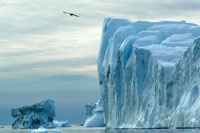 Dr. Sarah Das, from the Woods Hole Oceanographic Institute, spoke with students about her work studying large polar ice sheets in Greenland and Antarctica. Dr. Das, this year’s Science Assembly speaker, says that as the earth gets warmer, the ice melt is causing a rise in sea levels and this melt has accelerated in the past couple of decades. One of the research questions she explores is: How will polar ice sheets respond to future climate change?
Dr. Sarah Das, from the Woods Hole Oceanographic Institute, spoke with students about her work studying large polar ice sheets in Greenland and Antarctica. Dr. Das, this year’s Science Assembly speaker, says that as the earth gets warmer, the ice melt is causing a rise in sea levels and this melt has accelerated in the past couple of decades. One of the research questions she explores is: How will polar ice sheets respond to future climate change?
“The past can help us understand the future,” said Dr. Das, whose field work involves measuring physical and chemical characteristics of ice layers by digging snow pits and drilling ice cores. Science faculty member Matt Bingham spent two weeks last spring working with Dr. Das’s research team on the Disko Bay Ice Coring Project in Greenland. This past winter, students used techniques from that project to conduct research on ice formations right here on Milton’s campus.
Dr. Das showed students maps of predicted flooding in Boston if sea levels rose two, five and seven feet. She stressed that, “predictions of the future still require a better understanding of basic parameters and basic processes between the ocean, ice and atmosphere.”
One student asked what people can do now to stop polar ice melt. “It really comes down to carbon emissions,” Dr. Das said. “We need to reduce them but certain elements are what we call ‘locked into the system.’ Even if we reduced emissions to zero, which is not realistic, there will still be warming. Personally, I find we have to reduce emissions, explore geoengineering solutions and new solutions for energy.”